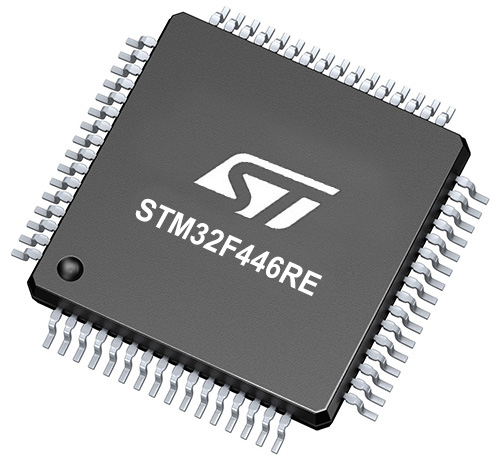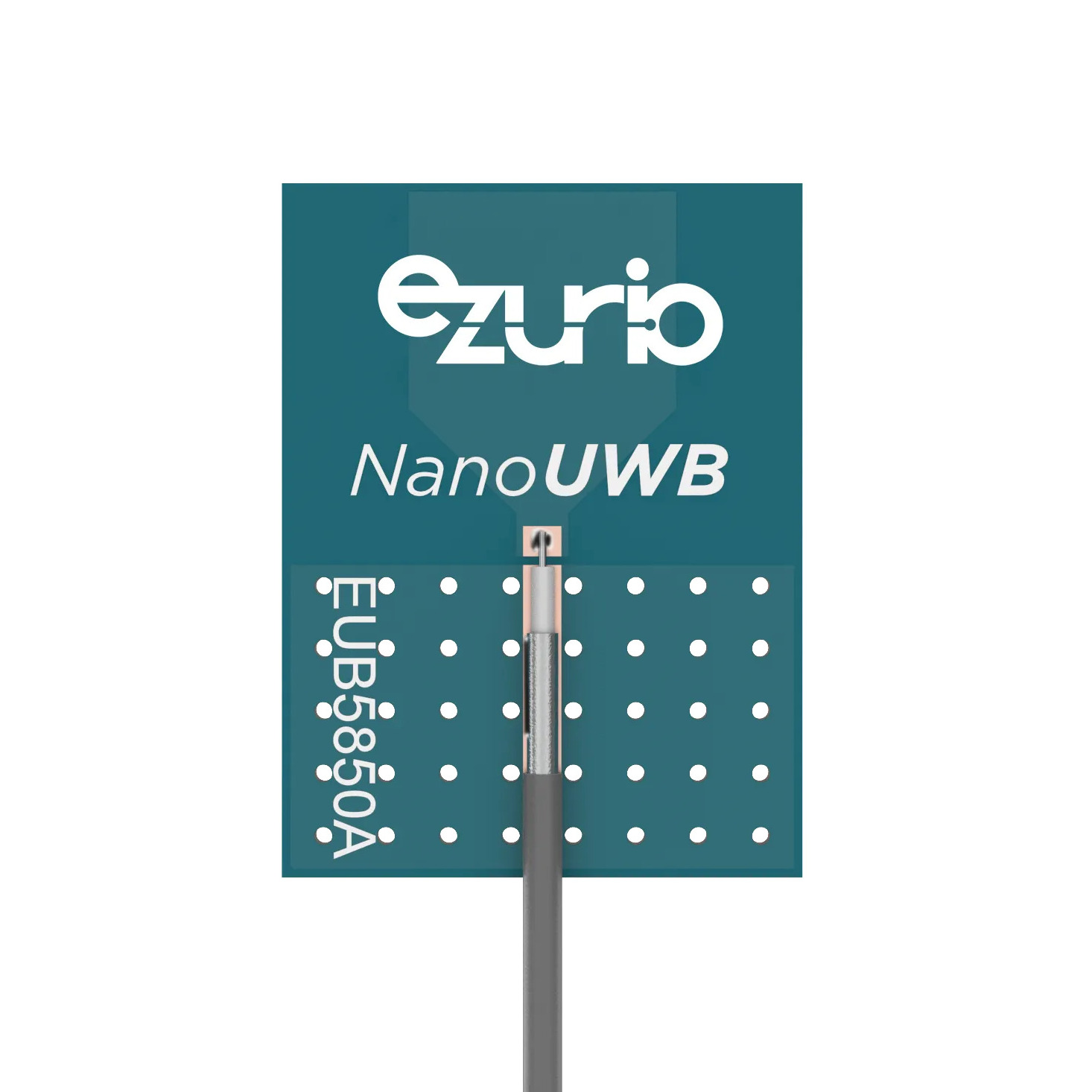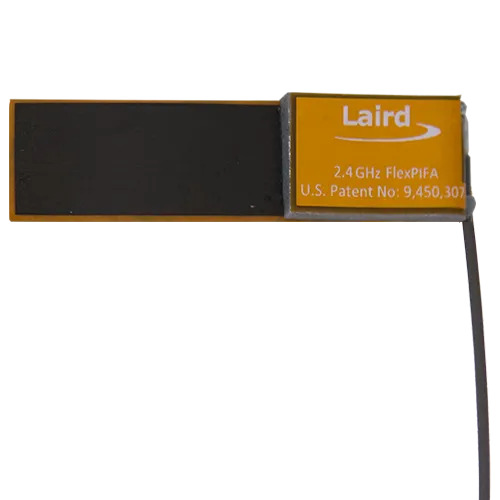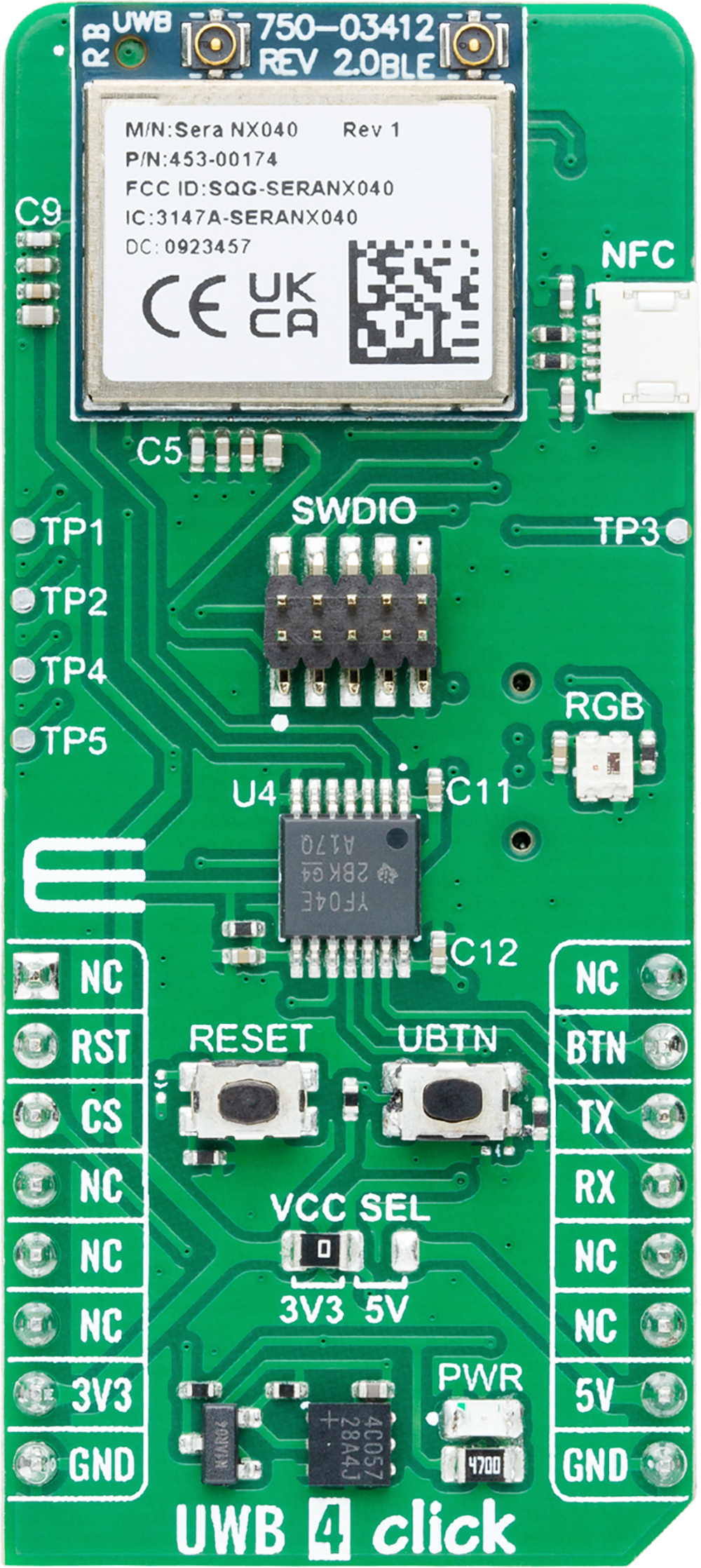将UWB(超宽带)用于精确测距,与Bluetooth LE(低功耗蓝牙)相结合,实现无线通信和数据传输,以便在精确的室内定位和基于位置的应用中使用
A
A
硬件概览
它是如何工作的?
UWB 4 Click 基于 Ezurio 的 Sera NX040(453-00174C),这是一款配备外部天线连接器的先进 UWB/BLE 模块。该模块采用顶级芯片:NXP 的 SR040 超宽带(UWB)芯片组和 Nordic Semiconductor 的 nRF52833 Bluetooth LE 芯片,提供在精确定位和无线通信方面的卓越性能。此外,该模块已预先校准以符合法规要求,并针对各种温度和 UWB 天线实现进行了优化,提供卓越的测距性能,使此 Click board™ 成为精确室内定位和基于位置的应用(如资产跟踪、导航和工业自动化)的理想选择。正如所提到的,Sera NX040 的核心是 NXP SR040 超宽带收发器,该收发器支持 IEEE 802.15.4/4z 高精度测距(HPR)UWB 操作。它包括一个完全嵌入的 FiRa 兼容 MAC 和 PHY,允许在发起者和响应者模式下无缝进行双向测距(TWR)会话,以及在到达时间差(TDoA)系统中的 Blink 模式操作。SR040 实现了小于 ±10cm 的卓越测距精度,典型接收灵敏度为 -92dBm。此外,模块还集成了 Nordic Semiconductor 的 nRF52833 芯片组,这是
一款完全认证的 Bluetooth SoC,支持 Bluetooth LE 5.4,可有效进行 UWB 测距会话的配置、设置和控制。nRF52833 提供最高 +8dBm 的发射功率和典型的 -96dBm 接收灵敏度。Sera NX040 通过标准 RX 和 TX 引脚通过 UART 接口与主机 MCU 通信。默认波特率为 115200bps,该设置确保了高效可靠的数据传输。除了 UART,此板还配备了用于 USB 2.0 FS(全速,12Mbps)的 USB Type-C 连接器,使其能够直接连接到 Sera NX040 模块的 USB 端口,实现灵活的集成。当使用 USB 接口时,整个系统由 MCP1826 LDO 稳压器提供的 3.3V 电源供电,该稳压器将 USB 的 5V 转换为 3.3V。为了开发和调试,模块提供了一个 SWDIO 接头,可访问 nRF52833 的 SWD(JTAG)接口,使其与 Nordic SDK 兼容。此接口对于利用高级功能和进行深入测试的开发人员至关重要。通过 Nordic SDK 提供全面的 USB 驱动程序支持,增强了模块在各种开发环境中的通用性。除了接口引脚外,此 Click board™ 还具有复位引脚(RST)和复位按钮用于模块重置。它还包括一个用
户引脚(BTN)和按钮(UBTN)用于交互式控制程序流。RGB LED 作为用户可配置的红色 LED 指示灯,提供各种状态的视觉反馈,如 UART 消息、启动过程或调试器命令。此外,该板还包括一个 NFC 天线连接器用于 NFC 应用和测试点用于调试和监控。TP1 和 TP2 作为 Sera NX040 的第二 UART 引脚,而 TP3、TP4 和 TP5 分别提供对 SR040 RST、SWCLK 和 SWDIO 引脚的访问。这些功能使测试和开发变得更加容易,使该板在广泛的应用中具有高度的通用性。在 UWB 4 Click 的底部,有 LP 切割痕迹。通过切割这些痕迹,可以通过断开 PWR LED 和 ClickID 电路来实现低功耗,从而节省额外的电力消耗。此 Click board™ 可以通过 VCC SEL 跳线选择使用 3.3V 或 5V 逻辑电压水平。由于 Sera NX040 模块在 3.3V 下工作,使用逻辑电平转换器 TXS0104 以实现正确操作和精确的信号电平转换。因此,3.3V 和 5V 兼容的 MCU 都可以正确使用通信线路。此外,这款 Click board™ 配备了包含易用功能的库和示例代码,可作为进一步开发的参考。
功能概述
开发板
Nucleo-64 搭载 STM32F446RE MCU 提供了一种经济高效且灵活的平台,供开发者探索新想法并原型设计他们的项目。该板利用 STM32 微控制器的多功能性,使用户能够为他们的项目选择最佳的性能与功耗平衡。它配备了 LQFP64 封装的 STM32 微控制器,并包含了如用户 LED(同时作为 ARDUINO® 信号)、用户和复位按钮,以及 32.768kHz 晶体振荡器用于精确的计时操作等基本组件。Nucleo-64 板设计考虑到扩展性和灵活性,它特有的 ARDUINO® Uno
V3 扩展连接器和 ST morpho 扩展引脚头,提供了对 STM32 I/O 的完全访问,以实现全面的项目整合。电源供应选项灵活,支持 ST-LINK USB VBUS 或外部电源,确保在各种开发环境中的适应性。该板还配备了一个具有 USB 重枚举功能的板载 ST-LINK 调试器/编程器,简化了编程和调试过程。此外,该板设计旨在简化高级开发,它的外部 SMPS 为 Vcore 逻辑供电提供高效支持,支持 USB 设备全速或 USB SNK/UFP 全速,并内置加密功能,提升了项目的功效
和安全性。通过外部 SMPS 实验的专用连接器、 用于 ST-LINK 的 USB 连接器以及 MIPI® 调试连接器,提供了更多的硬件接口和实验可能性。开发者将通过 STM32Cube MCU Package 提供的全面免费软件库和示例得到广泛支持。这些,加上与多种集成开发环境(IDE)的兼容性,包括 IAR Embedded Workbench®、MDK-ARM 和 STM32CubeIDE,确保了流畅且高效的开发体验,使用户能够充分利用 Nucleo-64 板在他们的项目中的能力。
微控制器概述
MCU卡片 / MCU

建筑
ARM Cortex-M4
MCU 内存 (KB)
512
硅供应商
STMicroelectronics
引脚数
64
RAM (字节)
131072
你完善了我!
配件
Click Shield for Nucleo-64 配备了两个专有的 mikroBUS™ 插座,使得所有的 Click board™ 设备都可以轻松地与 STM32 Nucleo-64 开发板连接。这样,Mikroe 允许其用户从不断增长的 Click boards™ 范围中添加任何功能,如 WiFi、GSM、GPS、蓝牙、ZigBee、环境传感器、LED、语音识别、电机控制、运动传感器等。您可以使用超过 1537 个 Click boards™,这些 Click boards™ 可以堆叠和集成。STM32 Nucleo-64 开发板基于 64 引脚封装的微控制器,采用 32 位 MCU,配备 ARM Cortex M4 处理器,运行速度为 84MHz,具有 512Kb Flash 和 96KB SRAM,分为两个区域,顶部区域代表 ST-Link/V2 调试器和编程器,而底部区域是一个实际的开发板。通过 USB 连接方便地控制和供电这些板子,以便直接对 Nucleo-64 开发板进行编程和高效调试,其中还需要额外的 USB 线连接到板子上的 USB 迷你接口。大多数 STM32 微控制器引脚都连接到了板子左右边缘的 IO 引脚上,然后连接到两个现有的 mikroBUS™ 插座上。该 Click Shield 还有几个开关,用于选择 mikroBUS™ 插座上模拟信号的逻辑电平和 mikroBUS™ 插座本身的逻辑电压电平。此外,用户还可以通过现有的双向电平转换器,使用任何 Click board™,无论 Click board™ 是否在 3.3V 或 5V 逻辑电压电平下运行。一旦将 STM32 Nucleo-64 开发板与我们的 Click Shield for Nucleo-64 连接,您就可以访问数百个工作于 3.3V 或 5V 逻辑电压电平的 Click boards™。
EUB5850A3S-10MH4L NanoUWB天线在5850-8250 MHz频率范围内工作,覆盖UWB通道5、6、7、8和9,提供强大的覆盖范围。凭借3-dBi的增益,该天线为超宽带应用确保了最佳性能。其快速简便的安装方式,加上在潮湿环境以及冷热循环中牢固粘附的背胶,使其成为各种环境下的可靠选择。该天线符合RoHS标准,具有多功能性,可安装在各种非导电表面、不同厚度的表面,甚至在自由空间中,为平面和开放式安装提供了灵活性。

001-0022 FlexPIFA天线专为2.4 GHz BLE应用设计,提供2400-2480 MHz的频率范围,具有+2.0 dBi的峰值增益和优于-1.5 dBi的平均增益。该天线具有线性极化和小于2.0:1的VSWR,确保了高效的信号传输,并具有50 Ω的阻抗。安装快速简便,并符合RoHS标准,其背胶在潮湿和温度波动等严苛条件下仍能牢固粘附。FlexPIFA天线可以安装在各种非导电表面、金属附近,甚至靠近人体,非常适合可穿戴设备和紧凑型设备。

使用的MCU引脚
mikroBUS™映射器
“仔细看看!”
Click board™ 原理图

一步一步来
项目组装
实时跟踪您的结果
应用程序输出
1. 应用程序输出 - 在调试模式下,“应用程序输出”窗口支持实时数据监控,直接提供执行结果的可视化。请按照提供的教程正确配置环境,以确保数据正确显示。

2. UART 终端 - 使用UART Terminal通过USB to UART converter监视数据传输,实现Click board™与开发系统之间的直接通信。请根据项目需求配置波特率和其他串行设置,以确保正常运行。有关分步设置说明,请参考提供的教程。

3. Plot 输出 - Plot功能提供了一种强大的方式来可视化实时传感器数据,使趋势分析、调试和多个数据点的对比变得更加直观。要正确设置,请按照提供的教程,其中包含使用Plot功能显示Click board™读数的分步示例。在代码中使用Plot功能时,请使用以下函数:plot(insert_graph_name, variable_name);。这是一个通用格式,用户需要将“insert_graph_name”替换为实际图表名称,并将“variable_name”替换为要显示的参数。

软件支持
库描述
该库包含 UWB 4 Click 驱动程序的 API。
关键功能:
uwb4_cmd_run- 此函数将指定命令发送到Click模块。uwb4_cmd_set- 此函数为Click模块的指定命令设置一个值。uwb4_reset_device- 此函数通过切换复位引脚的逻辑状态来重置设备。
开源
代码示例
完整的应用程序代码和一个现成的项目可以通过NECTO Studio包管理器直接安装到NECTO Studio。 应用程序代码也可以在MIKROE的GitHub账户中找到。
/*!
* @file main.c
* @brief UWB 4 Click Example.
*
* # Description
* This example demonstrates the use of UWB 4 Click board by showing
* the UWB ranging between two Click boards configured as initiator and responder.
*
* The demo application is composed of two sections :
*
* ## Application Init
* Initializes the driver and logger.
*
* ## Application Task
* Application task is split in few stages:
* - UWB4_POWER_UP:
* Powers up the device and reads system information.
* - UWB4_CONFIG_EXAMPLE:
* Configures device for UWB ranging.
* - UWB4_EXAMPLE:
* Reads and parses the UWB ranging information.
*
* ## Additional Function
* - static void uwb4_clear_app_buf ( void )
* - static void uwb4_log_app_buf ( void )
* - static err_t uwb4_process ( uwb4_t *ctx )
* - static err_t uwb4_read_response ( uwb4_t *ctx, uint8_t *rsp )
* - static err_t uwb4_power_up ( uwb4_t *ctx )
* - static err_t uwb4_config_example ( uwb4_t *ctx )
* - static err_t uwb4_example ( uwb4_t *ctx )
*
* @author Stefan Filipovic
*
*/
#include "board.h"
#include "log.h"
#include "uwb4.h"
#include "generic_pointer.h"
// Comment out the line below to switch the example mode to responder
#define EXAMPLE_INITIATOR
// Default config for initiator and responder examples
#ifdef EXAMPLE_INITIATOR
#define UWB_SESSION_ID "1234"
#define UWB_ROLE "0"
#define UWB_LOCAL_ADDRESS "1111"
#define UWB_REMOTE_ADDRESS "2222"
#define UWB_RANGING_INTERVAL "500"
#else
#define UWB_SESSION_ID "1234"
#define UWB_ROLE "1"
#define UWB_LOCAL_ADDRESS "2222"
#define UWB_REMOTE_ADDRESS "1111"
#define UWB_RANGING_INTERVAL "500"
#endif
static uwb4_t uwb4;
static log_t logger;
// Application buffer size
#define APP_BUFFER_SIZE 256
#define PROCESS_BUFFER_SIZE 256
static uint8_t app_buf[ APP_BUFFER_SIZE ] = { 0 };
static int32_t app_buf_len = 0;
/**
* @brief Example states.
* @details Predefined enum values for application example state.
*/
typedef enum
{
UWB4_POWER_UP = 1,
UWB4_CONFIG_EXAMPLE,
UWB4_EXAMPLE
} uwb4_app_state_t;
static uwb4_app_state_t app_state = UWB4_POWER_UP;
/**
* @brief UWB 4 clearing application buffer.
* @details This function clears memory of application buffer and reset its length.
* @note None.
*/
static void uwb4_clear_app_buf ( void );
/**
* @brief UWB 4 log application buffer.
* @details This function logs data from application buffer to USB UART.
* @note None.
*/
static void uwb4_log_app_buf ( void );
/**
* @brief UWB 4 data reading function.
* @details This function reads data from device and concatenates data to application buffer.
* @param[in] ctx : Click context object.
* See #uwb4_t object definition for detailed explanation.
* @return @li @c 0 - Read some data.
* @li @c -1 - Nothing is read.
* See #err_t definition for detailed explanation.
* @note None.
*/
static err_t uwb4_process ( uwb4_t *ctx );
/**
* @brief UWB 4 read response function.
* @details This function waits for a response message, reads and displays it on the USB UART.
* @param[in] ctx : Click context object.
* See #uwb4_t object definition for detailed explanation.
* @param[in] rsp Expected response.
* @return @li @c 0 - OK response.
* @li @c -2 - Timeout error.
* @li @c -3 - Command error.
* See #err_t definition for detailed explanation.
* @note None.
*/
static err_t uwb4_read_response ( uwb4_t *ctx, uint8_t *rsp );
/**
* @brief UWB 4 power up function.
* @details This function powers up the device and reads system information.
* @param[in] ctx : Click context object.
* See #uwb4_t object definition for detailed explanation.
* @return @li @c 0 - OK.
* @li @c != 0 - Read response error.
* See #err_t definition for detailed explanation.
* @note None.
*/
static err_t uwb4_power_up ( uwb4_t *ctx );
/**
* @brief UWB 4 config example function.
* @details This function configures device for UWB ranging.
* @param[in] ctx : Click context object.
* See #uwb4_t object definition for detailed explanation.
* @return @li @c 0 - OK.
* @li @c != 0 - Read response error.
* See #err_t definition for detailed explanation.
* @note None.
*/
static err_t uwb4_config_example ( uwb4_t *ctx );
/**
* @brief UWB 4 example function.
* @details This function reads and parses the UWB ranging information.
* @param[in] ctx : Click context object.
* See #uwb4_t object definition for detailed explanation.
* @return @li @c 0 - OK.
* @li @c != 0 - Read response error.
* See #err_t definition for detailed explanation.
* @note None.
*/
static err_t uwb4_example ( uwb4_t *ctx );
void application_init ( void )
{
log_cfg_t log_cfg; /**< Logger config object. */
uwb4_cfg_t uwb4_cfg; /**< Click config object. */
/**
* Logger initialization.
* Default baud rate: 115200
* Default log level: LOG_LEVEL_DEBUG
* @note If USB_UART_RX and USB_UART_TX
* are defined as HAL_PIN_NC, you will
* need to define them manually for log to work.
* See @b LOG_MAP_USB_UART macro definition for detailed explanation.
*/
LOG_MAP_USB_UART( log_cfg );
log_init( &logger, &log_cfg );
log_info( &logger, " Application Init " );
// Click initialization.
uwb4_cfg_setup( &uwb4_cfg );
UWB4_MAP_MIKROBUS( uwb4_cfg, MIKROBUS_1 );
if ( UART_ERROR == uwb4_init( &uwb4, &uwb4_cfg ) )
{
log_error( &logger, " Communication init." );
for ( ; ; );
}
log_info( &logger, " Application Task " );
app_state = UWB4_POWER_UP;
log_printf( &logger, ">>> APP STATE - POWER UP <<<\r\n\n" );
}
void application_task ( void )
{
switch ( app_state )
{
case UWB4_POWER_UP:
{
if ( UWB4_OK == uwb4_power_up( &uwb4 ) )
{
app_state = UWB4_CONFIG_EXAMPLE;
log_printf( &logger, ">>> APP STATE - CONFIG EXAMPLE <<<\r\n\n" );
}
break;
}
case UWB4_CONFIG_EXAMPLE:
{
if ( UWB4_OK == uwb4_config_example( &uwb4 ) )
{
app_state = UWB4_EXAMPLE;
log_printf( &logger, ">>> APP STATE - EXAMPLE <<<\r\n\n" );
}
break;
}
case UWB4_EXAMPLE:
{
uwb4_example( &uwb4 );
break;
}
default:
{
log_error( &logger, " APP STATE." );
break;
}
}
}
int main ( void )
{
/* Do not remove this line or clock might not be set correctly. */
#ifdef PREINIT_SUPPORTED
preinit();
#endif
application_init( );
for ( ; ; )
{
application_task( );
}
return 0;
}
static void uwb4_clear_app_buf ( void )
{
memset( app_buf, 0, app_buf_len );
app_buf_len = 0;
}
static void uwb4_log_app_buf ( void )
{
for ( int32_t buf_cnt = 0; buf_cnt < app_buf_len; buf_cnt++ )
{
log_printf( &logger, "%c", app_buf[ buf_cnt ] );
}
}
static err_t uwb4_process ( uwb4_t *ctx )
{
uint8_t rx_buf[ PROCESS_BUFFER_SIZE ] = { 0 };
int32_t overflow_bytes = 0;
int32_t rx_cnt = 0;
int32_t rx_size = uwb4_generic_read( ctx, rx_buf, PROCESS_BUFFER_SIZE );
if ( ( rx_size > 0 ) && ( rx_size <= APP_BUFFER_SIZE ) )
{
if ( ( app_buf_len + rx_size ) > APP_BUFFER_SIZE )
{
overflow_bytes = ( app_buf_len + rx_size ) - APP_BUFFER_SIZE;
app_buf_len = APP_BUFFER_SIZE - rx_size;
memmove ( app_buf, &app_buf[ overflow_bytes ], app_buf_len );
memset ( &app_buf[ app_buf_len ], 0, overflow_bytes );
}
for ( rx_cnt = 0; rx_cnt < rx_size; rx_cnt++ )
{
if ( rx_buf[ rx_cnt ] )
{
app_buf[ app_buf_len++ ] = rx_buf[ rx_cnt ];
}
}
return UWB4_OK;
}
return UWB4_ERROR;
}
static err_t uwb4_read_response ( uwb4_t *ctx, uint8_t *rsp )
{
#define READ_RESPONSE_TIMEOUT_MS 30000
uint32_t timeout_cnt = 0;
uwb4_clear_app_buf ( );
uwb4_process( ctx );
while ( ( 0 == strstr( app_buf, rsp ) ) &&
( 0 == strstr( app_buf, UWB4_RSP_ERROR ) ) )
{
uwb4_process( ctx );
if ( timeout_cnt++ > READ_RESPONSE_TIMEOUT_MS )
{
uwb4_clear_app_buf( );
log_error( &logger, " Timeout!" );
return UWB4_ERROR_TIMEOUT;
}
Delay_ms( 1 );
}
Delay_ms ( 200 );
uwb4_process( ctx );
if ( strstr( app_buf, rsp ) )
{
uwb4_log_app_buf( );
log_printf( &logger, "--------------------------------\r\n" );
return UWB4_OK;
}
log_error( &logger, " CMD!" );
return UWB4_ERROR_CMD;
}
static err_t uwb4_power_up ( uwb4_t *ctx )
{
err_t error_flag = UWB4_OK;
log_printf( &logger, ">>> Reset device.\r\n" );
uwb4_reset_device( &uwb4 );
while ( UWB4_OK == uwb4_process( ctx ) )
{
uwb4_log_app_buf( );
uwb4_clear_app_buf ( );
}
log_printf( &logger, "--------------------------------\r\n" );
log_printf( &logger, ">>> Check communication.\r\n" );
uwb4_cmd_run( &uwb4, UWB4_CMD_AT );
error_flag |= uwb4_read_response( &uwb4, UWB4_RSP_OK );
log_printf( &logger, ">>> Enable echo.\r\n" );
uwb4_cmd_run( &uwb4, UWB4_CMD_ENABLE_ECHO );
error_flag |= uwb4_read_response( &uwb4, UWB4_RSP_OK );
log_printf( &logger, ">>> Get module name.\r\n" );
uwb4_cmd_run( ctx, UWB4_CMD_GET_MODULE_NAME );
error_flag |= uwb4_read_response( ctx, UWB4_RSP_OK );
log_printf( &logger, ">>> Get device firmware version.\r\n" );
uwb4_cmd_run( ctx, UWB4_CMD_GET_FIRMWARE_VERSION );
error_flag |= uwb4_read_response( ctx, UWB4_RSP_OK );
log_printf( &logger, ">>> Get device serial number.\r\n" );
uwb4_cmd_run( ctx, UWB4_CMD_GET_UNIQUE_ID );
error_flag |= uwb4_read_response( ctx, UWB4_RSP_OK );
return error_flag;
}
static err_t uwb4_config_example ( uwb4_t *ctx )
{
err_t error_flag = UWB4_OK;
uint8_t param_buf[ 100 ] = { 0 };
#ifdef EXAMPLE_INITIATOR
log_printf( &logger, ">>> Create a new initiator UWB session.\r\n" );
#else
log_printf( &logger, ">>> Create a new responder UWB session.\r\n" );
#endif
strcpy( param_buf, UWB_SESSION_ID );
strcat( param_buf, "," );
strcat( param_buf, UWB_ROLE );
uwb4_cmd_set( ctx, UWB4_CMD_CREATE_SESSION, param_buf );
error_flag |= uwb4_read_response( ctx, UWB4_RSP_OK );
log_printf( &logger, ">>> Set local and remote addresses.\r\n" );
strcpy( param_buf, UWB_SESSION_ID );
strcat( param_buf, "," );
strcat( param_buf, UWB_LOCAL_ADDRESS );
strcat( param_buf, "," );
strcat( param_buf, UWB_REMOTE_ADDRESS );
uwb4_cmd_set( ctx, UWB4_CMD_SET_ADDRESS, param_buf );
error_flag |= uwb4_read_response( ctx, UWB4_RSP_OK );
log_printf( &logger, ">>> Set ranging interval.\r\n" );
strcpy( param_buf, UWB_SESSION_ID );
strcat( param_buf, "," );
strcat( param_buf, UWB_RANGING_INTERVAL );
uwb4_cmd_set( ctx, UWB4_CMD_SET_RANGING_INTERVAL, param_buf );
error_flag |= uwb4_read_response( ctx, UWB4_RSP_OK );
log_printf( &logger, ">>> Start the UWB session.\r\n" );
uwb4_cmd_set( ctx, UWB4_CMD_START_SESSION, UWB_SESSION_ID );
error_flag |= uwb4_read_response( ctx, UWB4_RSP_OK );
return error_flag;
}
static err_t uwb4_example ( uwb4_t *ctx )
{
err_t error_flag = UWB4_OK;
uint8_t session_id[ 10 ] = { 0 };
uint8_t remote_addr[ 10 ] = { 0 };
uint8_t distance[ 10 ] = { 0 };
log_printf( &logger, ">>> Reading distance to the remote device.\r\n" );
error_flag |= uwb4_read_response( ctx, UWB4_RSP_RANGE );
uint8_t * __generic_ptr start_ptr = strstr( app_buf, UWB4_RSP_RANGE );
uint8_t * __generic_ptr end_ptr = NULL;
if ( start_ptr )
{
start_ptr = start_ptr + strlen ( UWB4_RSP_RANGE );
end_ptr = strstr ( start_ptr, " " );
memcpy ( session_id, start_ptr, end_ptr - start_ptr );
start_ptr = end_ptr + 1;
end_ptr = strstr ( start_ptr, " " );
memcpy ( remote_addr, start_ptr, end_ptr - start_ptr );
start_ptr = end_ptr + 1;
end_ptr = strstr ( start_ptr, "\r\n" );
memcpy ( distance, start_ptr, end_ptr - start_ptr );
log_printf( &logger, ">>> Parse received message.\r\n" );
if ( strstr ( distance, "65535" ) )
{
log_printf ( &logger, " No remote device found.\r\n" );
}
else
{
log_printf ( &logger, " Session ID: %s\r\n", session_id );
log_printf ( &logger, " Remote address: %s\r\n", remote_addr );
log_printf ( &logger, " Distance: %s cm\r\n", distance );
}
log_printf( &logger, "--------------------------------\r\n" );
}
return error_flag;
}
// ------------------------------------------------------------------------ END

































